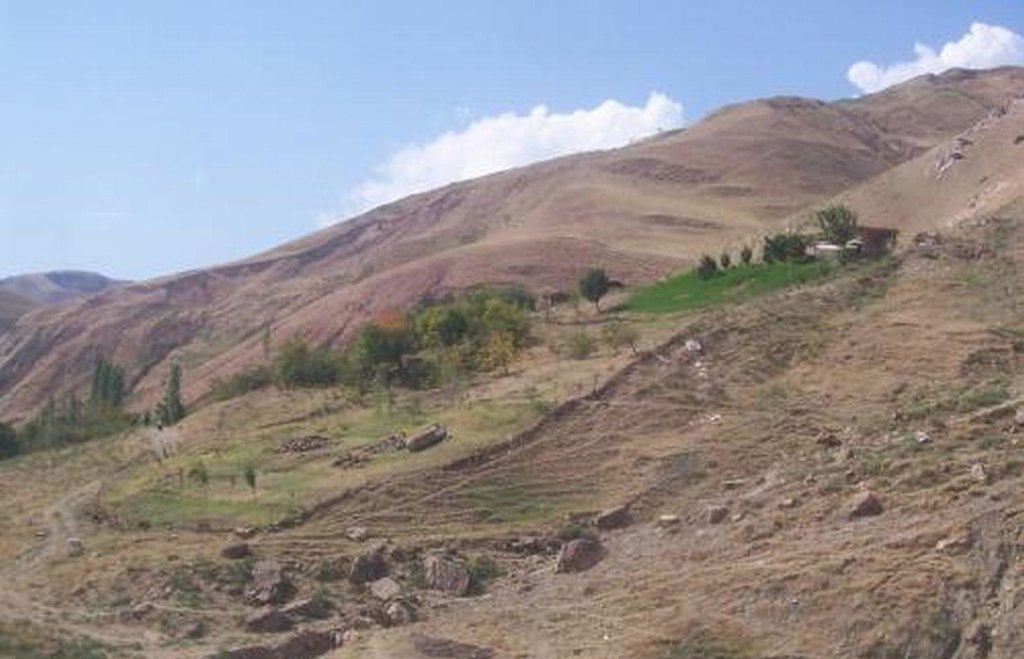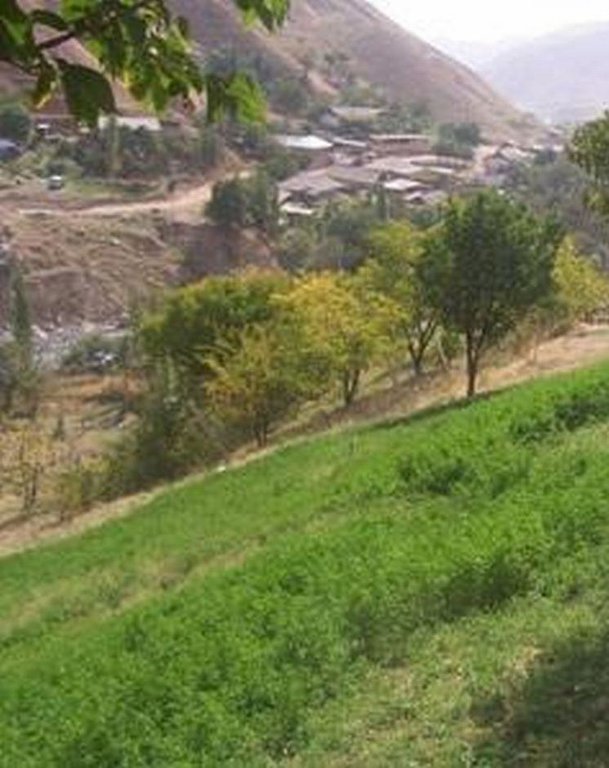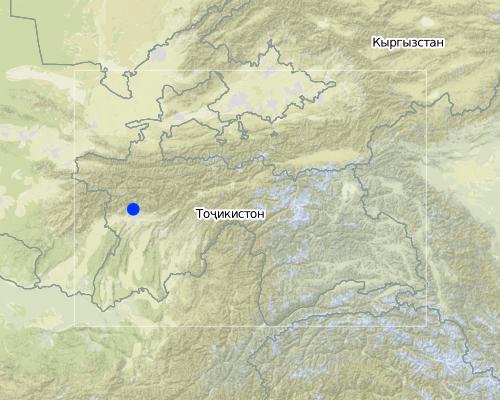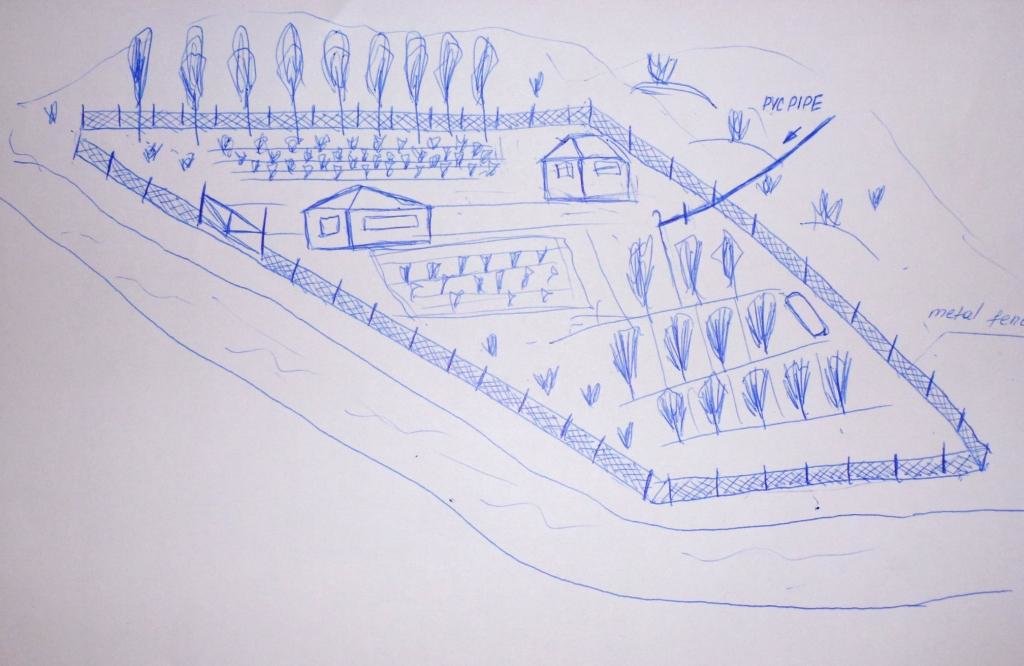Integrated Technologies for Household Plots [塔吉克斯坦]
- 创建:
- 更新:
- 编制者: Habib Kamolidinov
- 编辑者: –
- 审查者: David Streiff
technologies_1057 - 塔吉克斯坦
查看章节
全部展开 全部收起1. 一般信息
1.2 参与该技术评估和文件编制的资源人员和机构的联系方式
SLM专业人员:
有助于对技术进行记录/评估的机构名称(如相关)
GITEC/ADB/DMC Rural Development Project Land Management Institute - 塔吉克斯坦1.3 关于使用通过WOCAT记录的数据的条件
(现场)数据是什么时候汇编的?:
22/04/2011
编制者和关键资源人员接受有关使用通过WOCAT记录数据的条件。:
是
2. SLM技术的说明
2.1 技术简介
技术定义:
A fenced enclosure transformed with stone clearing and a small scale irrigation system, to grow a wide range of perennial, annual and orchard crops, beekeeping and small scale animal production.
2.2 技术的详细说明
说明:
A small area of previously severely eroded and almost devoid of vegetation area of land that was transformed through the building a perimeter fence, supplying a simple irrigation system and the planting of a diverse range of crops to provide a rich, integrated farming system. Activities then completed on this area included: orchard planting, perennial fodder crops (lucerne), garden vegetables, bee keeping for honey production and small scale animal rearing.
Purpose of the Technology: The farmer clearly stated that his prime, initial purpose in taking over this “ruined and abandoned land” was to improve and better guarantee the quality of his family’s lifestyle through enhanced and assured food and fodder production. He also recognised the potential for future profit through sale of his excess produce to market. Currently, the family has almost no need to buy food (and fodder) from nearby markets, apart from flour for bread making. This is a large cost saving. In hindsight, the farmer sees that he has dramatically improved land quality within the enclosure through mitigating erosion and increasing year-round vegetation cover.
Establishment / maintenance activities and inputs: The family (Enomali is the family name) first occupied this land in 1984. The first task was tree planting – a variety of orchard trees – on 0.1 ha of the current enclosure. This was fenced using abandoned wire and metal supports from old Russian factories. After nine family members left (to work in Dushanbe) the land user expanded the fence to the current 0.2 ha and continued to plant trees. He continued the stone removal through the 1990s and even up until the present day. Lucerne and vegetable gardens were initiated in the 1990s and continue to be enriched as required. Fodder, tree and vegetable production includes an ongoing set of tasks, as does the animal feeding with the home-grown fodder. Bee keeping is seasonal and the honey kept for home consumption. The land user continues to plant orchard trees every year and currently has more than 100. He gained a “certificate” of ownership” in 2008.
Natural / human environment: Before the family occupied this land, the land user stated that it was “totally ruined and abandoned”. That is why it was unoccupied. The family were prepared to work extremely hard to convert this ruined land to the green and productive “island” that it now is. The people in the area are dependent upon the produce of the land, however suitable land is in short supply and subject to population pressures.
2.3 技术照片
2.5 已应用该技术的、本评估所涵盖的国家/地区/地点
国家:
塔吉克斯坦
区域/州/省:
Central District of Tajikistan
有关地点的进一步说明:
Varzob
Map
×2.6 实施日期
如果不知道确切的年份,请说明大概的日期:
- 10-50年前
2.7 技术介绍
详细说明该技术是如何引入的:
- 通过土地使用者的创新
注释(项目类型等):
The land user developed the integrated approach to implentation of the technology.
3. SLM技术的分类
3.1 该技术的主要目的
- 改良生产
- rehabilitate severely degraded land
3.2 应用该技术的当前土地利用类型

农田
- 一年一作
- 多年一作(非木材)
- 乔木与灌木的种植
主要农作物(经济作物及粮食作物):
major food crop: Fruit, vegetables, honey, lucerne for fodder and orchard fruits

混合(作物/放牧/树木),包括农林
- 农林业
主要产品/服务:
Cut-and-carry/zero grazing, fruits and nuts
注释:
Major land use problems (compiler’s opinion): Massive water erosion causing gullies, sheet washing and landslides. This leads to land denudation of the soil and vegetation. Almost total lack of soil organic matter and above/below ground biodiversity. No water holding capacity of the land – combination of steep slopes and no vegetation causes all rainwater to immediately runoff.
Major land use problems (land users’ perception): Same – the above words were used by the farmer in the on-farm interview.
Cut-and-carry/ zero grazing: Yes
Other type of forest: orchard species
Forest products and services: fruits and nuts
Future (final) land use (after implementation of SLM Technology): Mixed: Mf: Agroforestry
如果由于技术的实施而导致土地用途发生变化,则在技术实施前说明土地利的用途。:
Grazing land: Ge: Extensive grazing land
3.3 有关土地利用的更多信息
该技术所应用土地的供水:
- 混合雨水灌溉
每年的生长季节数:
- 1
具体说明:
Longest growing period in days: 180Longest growing period from month to month: April to September
牲畜密度(如相关):
< 1 LU/km2
3.4 该技术所属的SLM组
- 农业林学
- 改良的地面/植被覆盖
- 改良植物品种/动物品种
3.5 技术传播
具体说明该技术的分布:
- 均匀地分布在一个区域
如果该技术均匀地分布在一个区域上,请注明覆盖的大致区域。:
- < 0.1 平方千米(10 公顷)
注释:
The small area was all that the family could manage as there was an initial large workload, clearing stones and fence building, etc
3.6 包含该技术的可持续土地管理措施

农艺措施
- A1:植被和土壤覆盖层

植物措施
- V1:乔木和灌木覆盖层

结构措施
- S6:墙、障碍物、栅栏、围墙

管理措施
- M1:改变土地使用类型
注释:
Main measures: agronomic measures, vegetative measures, structural measures
Type of agronomic measures: better crop cover, mixed cropping / intercropping, cover cropping, retaining more vegetation cover, furrows (drainage, irrigation)
Type of vegetative measures: in blocks
3.7 该技术强调的主要土地退化类型

土壤水蚀
- Wt:表土流失/地表侵蚀
- Wg:冲沟侵蚀/沟蚀
- Wm:块体运动/滑坡

生物性退化
- Bc:植被覆盖的减少
- Bh:栖息地丧失
- Bq:数量/生物量减少
- Bl:土壤寿命损失
注释:
Main type of degradation addressed: Wt: loss of topsoil / surface erosion, Wg: gully erosion / gullying, Wm: mass movements / landslides, Bc: reduction of vegetation cover, Bl: loss of soil life
Secondary types of degradation addressed: Bh: loss of habitats, Bq: quantity / biomass decline
Main causes of degradation: deforestation / removal of natural vegetation (incl. forest fires) (Post Soviet era – massive forest clearing for firewood), over-exploitation of vegetation for domestic use (Exploitation of fire wood.), overgrazing (massive overgrazing of an already depleted land resource), other natural causes (avalanches, volcanic eruptions, mud flows, highly susceptible natural resources, extreme topography, etc.) specify (Loess landscape – highly susceptible to water erosion – massively exacerbated by vegetation clearing (tree chopping and animal grazing))
Secondary causes of degradation: population pressure, poverty / wealth, war and conflicts (increased natural resource pressure during the civil war.)
3.8 防止、减少或恢复土地退化
具体数量名该技术与土地退化有关的目标:
- 修复/恢复严重退化的土地
注释:
Secondary goals: prevention of land degradation, mitigation / reduction of land degradation
4. 技术规范、实施活动、投入和成本
4.1 该技术的技术图纸
4.2 技术规范/技术图纸说明
The drawing shows an enclosed area, a fence line consisting of wire fencing, brush and scrap metal materials. At the top of the slope a row of fast growing poplars was planted to protect the enclosure and the adjacent vegetable plot from the wind and rain. Perenials are intercropped with fruit trees further below the dwelling and the area is fed by an irrigation pipe originating from a local spring.
Location: Tajikistan. Varzob, Luchob
Date: 28 April 2011
Technical knowledge required for field staff / advisors: moderate (If training was provided to replicate the technology.)
Technical knowledge required for land users: moderate
Main technical functions: control of raindrop splash, control of dispersed runoff: impede / retard, improvement of ground cover, improvement of topsoil structure (compaction), increase in nutrient availability (supply, recycling,…), increase / maintain water stored in soil, increase of biomass (quantity), promotion of vegetation species and varieties (quality, eg palatable fodder)
Secondary technical functions: increase of surface roughness, improvement of surface structure (crusting, sealing), increase in organic matter, increase of infiltration, water spreading, improvement of water quality, buffering / filtering water, reduction in wind speed, spatial arrangement and diversification of land use
Better crop cover
Material/ species: Perennial lucerne for fodder
Quantity/ density: 100% cover
Remarks: 0.1 ha
Cover cropping
Material/ species: Lucerne is a cover crop
Retaining more vegetation cover
Material/ species: Land previously bare
Agronomic measure: other
Material/ species: Perennial legume pasture species - lucerne
Quantity/ density: 0.1 ha
Furrows (drainage, irrigation)
Material/ species: Irrigation via hand cut 20cm cube ditches and poly pipe
Aligned: -contour
Vegetative material: T : trees / shrubs
Scattered / dispersed
Vegetative material: T : trees / shrubs
In blocks
Number of plants per (ha): 100%
Vertical interval between rows / strips / blocks (m): about 0.1 ha planted
Fruit trees / shrubs species: Apple, cherry, apricot, pear
Perennial crops species: lucerne
Other species: Vegetable garden
Slope (which determines the spacing indicated above): 38.30%
Gradient along the rows / strips: 5.24%
Wall/ barrier
Depth of ditches/pits/dams (m): 1
Length of ditches/pits/dams (m): 1000
Slope (which determines the spacing indicated above): 21 degrees – measured with cli%
Lateral gradient along the structure: 3 degrees%
4.3 有关投入和成本计算的一般信息
其它/国家货币(具体说明):
somoni
注明美元与当地货币的汇率(如相关):1美元=:
4.5
注明雇用劳工的每日平均工资成本:
5.50
4.4 技术建立活动
| 活动 | 措施类型 | 时间 | |
|---|---|---|---|
| 1. | Fence building | 结构性的 | At the start |
| 2. | Irrigation pipes | 结构性的 | At the start |
| 3. | Tree planting | 植物性的 | At the start |
| 4. | Cover cropping (lucerne replanting) | 农业学的 | annually |
| 5. | Small vegetable beds | 农业学的 | annually |
| 6. | Vegetable garden | 农业学的 | annually |
4.5 技术建立所需要的费用和投入
| 对投入进行具体说明 | 单位 | 数量 | 单位成本 | 每项投入的总成本 | 土地使用者承担的成本% | |
|---|---|---|---|---|---|---|
| 劳动力 | Fence building | Persons/day | 100.0 | 25.0 | 2500.0 | 100.0 |
| 劳动力 | Tree planting | Persons/day | 10.0 | 25.0 | 250.0 | 100.0 |
| 劳动力 | Cover cropping | Persons/day | 5.0 | 25.0 | 125.0 | 100.0 |
| 劳动力 | Vegetable garden | Persons/day | 50.0 | 25.0 | 1250.0 | 100.0 |
| 植物材料 | Trees | Pieces | 50.0 | 10.0 | 500.0 | 100.0 |
| 植物材料 | Plants | Pieces | 3000.0 | 0.33333333 | 1000.0 | 100.0 |
| 施工材料 | Fence | meter | 200.0 | 2.25 | 450.0 | 100.0 |
| 施工材料 | Irrigation pipe | meter | 1500.0 | 1.5 | 2250.0 | 100.0 |
| 其它 | Labour: Small vegetable beds | Persons/day | 20.0 | 25.0 | 500.0 | 100.0 |
| 技术建立所需总成本 | 8825.0 | |||||
注释:
Duration of establishment phase: 48 month(s)
4.6 维护/经常性活动
| 活动 | 措施类型 | 时间/频率 | |
|---|---|---|---|
| 1. | Better crop cover and cover cropping | 农业学的 | Annually |
| 2. | Stone clearing | 农业学的 | Annually |
| 3. | Vegetable garden | 农业学的 | Annually |
| 4. | Animal husbandry (and bee keeping) | 农业学的 | Annual |
| 5. | Fertilising (garden vegetables) | 农业学的 | Annual |
| 6. | Tree planting | 植物性的 | Annually |
| 7. | Lucerne reseeding | 植物性的 | Annually |
| 8. | Vegetable planting | 植物性的 | Annually |
| 9. | Small vegetable beds | 结构性的 | Annual |
4.7 维护/经常性活动所需要的费用和投入(每年)
| 对投入进行具体说明 | 单位 | 数量 | 单位成本 | 每项投入的总成本 | 土地使用者承担的成本% | |
|---|---|---|---|---|---|---|
| 劳动力 | Better crop cover and cover cropping | Persons/day | 10.0 | 25.0 | 250.0 | 100.0 |
| 劳动力 | Stone clearing | Persons/day | 10.0 | 25.0 | 250.0 | 100.0 |
| 劳动力 | Vegetable garden incl. fertilizing | Persons/day | 15.0 | 25.0 | 375.0 | 100.0 |
| 劳动力 | Animal husbandry (and bee keeping) | Persons/day | 40.0 | 25.0 | 1000.0 | 100.0 |
| 其它 | Labour: Tree planting | Persons/day | 10.0 | 25.0 | 250.0 | 100.0 |
| 其它 | Labour: Lucerne reseeding | Persons/day | 10.0 | 25.0 | 250.0 | 100.0 |
| 其它 | Labour: Vegetable planting | Persons/day | 50.0 | 25.0 | 1250.0 | 100.0 |
| 其它 | Labour: Preparing small vegetable beds | Persons/day | 20.0 | 25.0 | 500.0 | 100.0 |
| 技术维护所需总成本 | 4125.0 | |||||
注释:
Machinery/ tools: All work is done manually. There is one mule available to aid with carrying fodder and rocks., All works done manually. Mule assists with heavy lifting and carrying.
The area is approximately one hectare in total, however the costs are spread over a period of time up to 2010.
4.8 影响成本的最重要因素
描述影响成本的最决定性因素:
The human labour costs (I believe) are most misleading. The farmer and his family happily and willingly committed their time and effort over a period of 27 years to improving this piece of land – as they knew that their family lifestyle would vastly improve and be greatly assured through their efforts. As the farmer said during the interview: “What else would I be doing?” Meaning – this is his life and he thoroughly enjoyed the inputs, realising the richness of the outputs.
Fence costs were minimal (a few hundred dollars) as on departure of the Russians after the Soviet period, the factories were ransacked by locals for metals of all types, not a sustainable practice, but at this time gave locals access to free materials to use. In this case for fencing.
Trees – there was an initial set up cost and the farmer said he tries to plant at least 20 new trees each year to maintain and enhance productivity.
Lucerne – there was a set up cost (farmer forgets how much – but approx. $50) for seed. But now the lucerne is almost self-regenerating (from it's own seeds) as the last cut each year is for seed production that the farmer spreads in the lucerne field.
5. 自然和人文环境
5.1 气候
年降雨量
- < 250毫米
- 251-500毫米
- 501-750毫米
- 751-1,000毫米
- 1,001-1,500毫米
- 1,501-2,000毫米
- 2,001-3,000毫米
- 3,001-4,000毫米
- > 4,000毫米
有关降雨的规范/注释:
Dominate in Spring (March-May) The period June to September is very hot and dry (almost no rainfall)
农业气候带
- 半干旱
Thermal climate class: temperate
5.2 地形
平均坡度:
- 水平(0-2%)
- 缓降(3-5%)
- 平缓(6-10%)
- 滚坡(11-15%)
- 崎岖(16-30%)
- 陡峭(31-60%)
- 非常陡峭(>60%)
地形:
- 高原/平原
- 山脊
- 山坡
- 山地斜坡
- 麓坡
- 谷底
垂直分布带:
- 0-100 m a.s.l.
- 101-500 m a.s.l.
- 501-1,000 m a.s.l.
- 1,001-1,500 m a.s.l.
- 1,501-2,000 m a.s.l.
- 2,001-2,500 m a.s.l.
- 2,501-3,000 m a.s.l.
- 3,001-4,000 m a.s.l.
- > 4,000 m a.s.l.
说明该技术是否专门应用于:
- 凸形情况
关于地形的注释和进一步规范:
Altitudinal zone: The site is exactly at 1,180 meters a.s.l.
5.3 土壤
平均土层深度:
- 非常浅(0-20厘米)
- 浅(21-50厘米)
- 中等深度(51-80厘米)
- 深(81-120厘米)
- 非常深(> 120厘米)
土壤质地(表土):
- 中粒(壤土、粉土)
表土有机质:
- 高(>3%)
如有可能,附上完整的土壤描述或具体说明可用的信息,例如土壤类型、土壤酸碱度、阳离子交换能力、氮、盐度等。:
Soil texture: Loess soil – silty loam
Soil fertility is high with proper management (as in intervention) these soils are very fertile. Before the intervention –extremely low fertility
Topsoil organic matter was before intervention <1%
Soil water storage capacity is medium
5.4 水资源可用性和质量
地下水位表:
5-50米
地表水的可用性:
好
水质(未处理):
良好饮用水
关于水质和水量的注释和进一步规范:
Availability of surface water was medium before the intervention.
Water quality (untreated) is good because the spring water is almost pure water.
5.5 生物多样性
物种多样性:
- 中等
关于生物多样性的注释和进一步规范:
But it will have improved with intervention through dramatically increased vegetation cover
5.6 应用该技术的土地使用者的特征
生产系统的市场定位:
- 生计(自给)
非农收入:
- 收入的10-50%
个人或集体:
- 个人/家庭
机械化水平:
- 手工作业
- 畜力牵引
说明土地使用者的其他有关特征:
Difference in the involvement of women and men: There is not a great difference. The farmer’s wife shares the workload but tends to focus more on the garden, fruit production, household duties and bee keeping. The farmer generally conducts hay cutting and gathering, stone removal, fence upkeep and animal tending (feeding and slaughtering when required).
Population density: < 10 persons/km2
Annual population growth: 1% - 2%
10% of the land users are average wealthy.
80% of the land users are poor.
10% of the land users are poor.
Off-farm income specification: The issue is that it tends to be the older and very young family members (ie Mr Enomali and his wife are in their late 50s, and their pre-school age grandchildren stay with them) stay on the farm. The others (18 to 50 yrs old) have paid employment in Dushanbe and Russia – and only visit the farm occasionally. However, it is believed they part-finance (contribute) to the upkeep of the family farm.
Market orientation of production system: All of the farm produce stays on the farm for home consumption, but they do eat well and very healthy (fresh and organic) food.
Level of mechanization: Normally manual but with one mule to help with heavy work.
5.7 应用该技术的土地使用者拥有或租用的平均土地面积
- < 0.5 公顷
- 0.5-1 公顷
- 1-2 公顷
- 2-5公顷
- 5-15公顷
- 15-50公顷
- 50-100公顷
- 100-500公顷
- 500-1,000公顷
- 1,000-10,000公顷
- > 10,000公顷
5.8 土地所有权、土地使用权和水使用权
土地所有权:
- 州
土地使用权:
- 个人
注释:
Not yet an issue – as he is the only one with access to the spring water.
5.9 进入服务和基础设施的通道
健康:
- 贫瘠
- 适度的
- 好
教育:
- 贫瘠
- 适度的
- 好
技术援助:
- 贫瘠
- 适度的
- 好
就业(例如非农):
- 贫瘠
- 适度的
- 好
市场:
- 贫瘠
- 适度的
- 好
能源:
- 贫瘠
- 适度的
- 好
道路和交通:
- 贫瘠
- 适度的
- 好
饮用水和卫生设施:
- 贫瘠
- 适度的
- 好
金融服务:
- 贫瘠
- 适度的
- 好
6. 影响和结论性说明
6.1 该技术的现场影响
社会经济效应
生产
作物生产
SLM之前的数量:
0
注释/具体说明:
Prior to the technology this land was “ruined, denuded wasteland” that had almost no carrying capacity, no productivity and no water supply, so the % increase as a result of the technology is from a starting point of zero.
饲料生产
SLM之前的数量:
0
饲料质量
SLM之前的数量:
0
畜牧生产
SLM之前的数量:
2
木材生产
SLM之前的数量:
0
生产故障风险
SLM之前的数量:
0
产品多样性
SLM之前的数量:
0
生产区域
SLM之前的数量:
0
土地管理
SLM之前的数量:
0
水资源可用性和质量
饮用水的可用性
SLM之前的数量:
0
家畜用水的可用性
家畜用水的质量
灌溉用水的可用性
灌溉用水的质量
收入和成本
农业投入费用
SLM之前的数量:
0
农业收入
SLM之前的数量:
0
收入来源的多样性
SLM之前的数量:
0
工作量
社会文化影响
食品安全/自给自足
健康状况
文化机会
娱乐机会
SLM/土地退化知识
社会经济弱势群体的情况
Livelihood and human well-being
注释/具体说明:
The primary aim of the farmer in introducing the Technology was to improve the family’s lifestyle and well being. He has easily achieved this and it seems to be getting better, year on year. The family have improved their food security and quality.
生态影响
水循环/径流
水量
SLM之前的数量:
0
水质
SLM之前的数量:
0
水的回收/收集
SLM之前的数量:
0
地表径流
SLM之前的数量:
0
多余水的排放
SLM之前的数量:
0
蒸发
SLM之前的数量:
0
土壤
土壤水分
SLM之前的数量:
0
土壤覆盖层
SLM之前的数量:
0
土壤流失
SLM之前的数量:
0
土壤结壳/密封
SLM之前的数量:
0
土壤压实
SLM之前的数量:
0
养分循环/补给
SLM之前的数量:
0
生物多样性:植被、动物
生物量/地上C
SLM之前的数量:
0
植物多样性
SLM之前的数量:
0
其它生态影响
Hazard towards adverse events
6.2 该技术的场外影响已经显现
水资源可用性
SLM之前的数量:
0
旱季稳定可靠的水流
下游洪水
注释/具体说明:
As the Technology has so revolutionised the productive capacity and sustainability of the site, there are no obvious disadvantages.
下游淤积
缓冲/过滤能力
对邻近农田的破坏
6.3 技术对渐变气候以及与气候相关的极端情况/灾害的暴露和敏感性(土地使用者认为的极端情况/灾害)
渐变气候
渐变气候
| 季节 | 气候变化/极端天气的类型 | 该技术是如何应对的? | |
|---|---|---|---|
| 年温度 | 增加 | 好 |
气候有关的极端情况(灾害)
气象灾害
| 该技术是如何应对的? | |
|---|---|
| 局地暴雨 | 好 |
| 局地风暴 | 好 |
气候灾害
| 该技术是如何应对的? | |
|---|---|
| 干旱 | 好 |
水文灾害
| 该技术是如何应对的? | |
|---|---|
| 比较和缓的(河道)洪水 | 未知 |
其他气候相关的后果
其他气候相关的后果
| 该技术是如何应对的? | |
|---|---|
| 缩短生长期 | 好 |
6.4 成本效益分析
技术收益与技术建立成本相比如何(从土地使用者的角度看)?
短期回报:
消极
长期回报:
非常积极
技术收益与技术维护成本/经常性成本相比如何(从土地使用者的角度看)?
短期回报:
非常积极
长期回报:
非常积极
注释:
The establishment and ongoing costs are very small in comparison to the long and short term benefits. If natural materials cannot be used for fencing materials, then the initial establishment costs will be higher.
6.5 技术采用
- 单例/实验
如若可行,进行量化(住户数量和/或覆盖面积):
1 household
在所有采用这项技术的人当中,有多少人是自发地采用该技术,即未获得任何物质奖励/付款?:
- 90-100%
注释:
100% of land user families have adopted the Technology without any external material support
There is a little trend towards spontaneous adoption of the Technology
Comments on adoption trend: There are (seemingly) quite a few enclosures already in this area – but these have not been reviewed.
6.7 该技术的优点/长处/机会
| 土地使用者眼中的长处/优势/机会 |
|---|
|
The land provided food security and a small income for my family. How can they be sustained / enhanced? To replicate it, maybe small grants and loans could be awarded. |
| 编制者或其他关键资源人员认为的长处/优势/机会 |
|---|
|
The fence building started and underpins the whole SLM initiative. That it was achieved by only 2-3 people, in a one year period and at low cost (using mainly scrap materials) adds to the strengths. How can they be sustained / enhanced? The farmer wishes to expand his fenced area so the enclosure is 1 ha in size |
|
Bringing water to the site (at his own cost) by poly pipe was a critical part to the technology. The land in the enclosure would probably have improved anyway, due to animal exclusion, but this was greatly improved by the provison of irrigation water. This is relatively a small volume of water, but it is available all year round which is key to the plants being able to survive through the hot summer months. How can they be sustained / enhanced? The farmer wishes to source a 2nd spring to water the extended (1 ha) site |
|
The rich mix of vegetation on the site (trees, perennial fodder legume and vegetable production) not only ensures the intervention remains viable but also ensures a continuous, rich, healthy food supply to the family all year round How can they be sustained / enhanced? The farmer has already started to plant new fruit trees outside the fence area, in readiness for moving the fence to encompass a 1 ha site |
|
Clearing stones was an important technological input, to greatly increase the available “growth area” for the introduced plants and trees as well as maintain soil depth. Linked to the irrigation system, the increased soil depth has greatly aided the vitality of this SLM approach – especially in the hot summer months. How can they be sustained / enhanced? Stone clearing will be a critical phase of the expansion of the enclosure to 1 ha. |
6.8 技术的弱点/缺点/风险及其克服方法
| 土地使用者认为的弱点/缺点/风险 | 如何克服它们? |
|---|---|
| It is a lengthy process to secure land certificates. |
| 编制者或其他关键资源人员认为的弱点/缺点/风险 | 如何克服它们? |
|---|---|
| Enclosing the land is important, however the cost of the wire fence becomes an issue. | There may be access to finance through the bank or from relatives. |
| The success of the project is dependent upon the supply of irrigated water to supplement the rainfed supply. | Areas for replication need to be assessed for water supply. There is also potential that drip irrigation schemes could help support the implementation of the technology. |
链接和模块
全部展开 全部收起链接
无链接
模块
无模块







